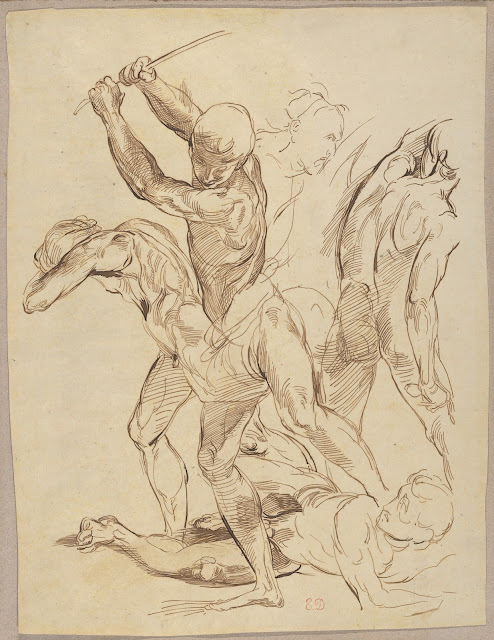 |
| Eugène Delacroix Crouching Tiger 1839 drawing Metropolitan Museum of Art, New York |
 |
| Eugène Delacroix Lioness and caricature of Ingres ca. 1850-60 drawing Metropolitan Museum of Art, New York |
 |
| Eugène Delacroix Studies of a Lion and a Female Nude ca. 1845 drawing Metropolitan Museum of Art, New York |
"In 1815 Delacroix, aged seventeen, began to take painting lessons from Pierre Guérin, through whose studio Théodore Gericault had briefly and turbulently passed a little earlier. Guérin was a tolerant teacher who attracted the sons of the middle class. His classicist instruction had little effect on Delacroix; it was less important for his development than the literary education he had received at the lycée. The example of Gericault with whom he was acquainted and for whose Raft of the Medusa he posed in 1818 left its mark on him, but in every essential respect he was, like many of his contemporaries, a self-taught artist, whose real school was the Louvre, where, even after the removal of the Napoleonic loot, the splendor of Titian, Veronese, and Rubens shone brightly enough to eclipse the school of David. Among his fellow copyists in its galleries he met the young Englishman Richard Parkes Bonington who, together with his friend Raymond Soulier, was to introduce him to watercolor painting and a British tradition of colorism, and who helped to awaken his interest in Shakespeare, Byron, and Scott, the main literary sources of his romanticism."
 |
| Eugène Delacroix Combat of Nude Men, after Raphael ca. 1823 drawing Metropolitan Museum of Art, New York |
 |
| Eugène Delacroix Figure studies for the Salon du Roi, Palais Bourbon 1833-35 drawing Metropolitan Museum of Art, New York |
"Behind Delacroix' new concern with compositional structure and balance lay the experience he had gained in carrying out the architectural decorations that occupied him during the latter part of his life. The governments of Louis-Philippe and Napoleon III favored him with important monumental commissions, beginning in 1833 with the allegorical decorations for the Salon du Roi in the Palais Bourbon (Chamber of Deputies). This was closely followed by the even larger enterprise of the Palais Bourbon's library (1838-1847) where Delacroix covered a succession of domes and pendentives with scenes celebrating the heroic lineage of the arts and sciences, in a dramatic succession beginning the Orpheus' gift of civilization to mankind and ending with Attila's destruction of Italy."
 |
| Eugène Delacroix Studies of Hands and Figures for the Salon du Roi, Palais Bourbon ca. 1833-38 drawing Metropolitan Museum of Art, New York |
 |
| Eugène Delacroix The Tribute Money - Study for the Library of Palais Bourbon 1843 drawing Metropolitan Museum of Art, New York |
 |
| Eugène Delacroix Studies of Fallen Male Nude for Hercules and the Horses of Diomedes 1852 drawing Metropolitan Museum of Art, New York |
 |
| Eugène Delacroix Seated and Standing Male Nudes after photographs by Eugène Durieu 1855 drawing Metropolitan Museum of Art, New York |
 |
| Eugène Delacroix Ecorché - Torso of a Male Cadaver ca. 1828 drawing Metropolitan Museum of Art, New York |
 |
| Eugène Delacroix Ecorché - Three Studies of a Male Cadaver before 1863 drawing Metropolitan Museum of Art, New York |
 |
| Eugène Delacroix The Triumph of Genius over Envy ca. 1849-51 drawing Metropolitan Museum of Art, New York |
"The Universal Exposition of 1855 showed thirty-six of his paintings, a tribute to him (together with Ingres) as one of France's two preeminent living artists. Having long been denied admission to the Academy, of which he privately took a coolly realistic view, he was at last admitted to this body of distinguished mediocrities in 1857. Frequently ill with bronchial infections and economizing his physical strength, he lived a frugal bachelor's life but worked with unabated energy until the end of his life. For all his courtesy, his person could command awe and, on occasion, a secret terror."
 |
| Eugène Delacroix Studies of Male Heads and Figures before 1863 wash drawing and watercolor Metropolitan Museum of Art, New York |
 |
| Eugène Delacroix The Giaour on Horseback ca. 1824-26 drawing Metropolitan Museum of Art, New York |
– quoted passages are from the biography of Delacroix in the Systematic Catalogue of the National Gallery of Art, Washington DC